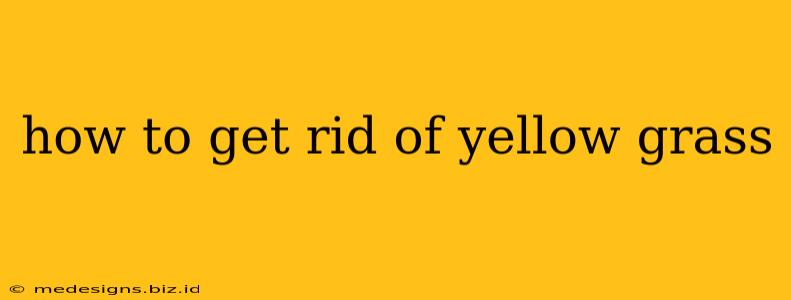A vibrant green lawn is the envy of any homeowner. But what happens when your once-lush grass turns a sickly yellow? Don't despair! Yellow grass isn't always a death sentence. This comprehensive guide will walk you through the common causes of yellow grass and provide effective solutions to restore your lawn to its former glory.
Identifying the Cause of Yellow Grass
Before you start treating your yellow grass, you need to diagnose the problem. Several factors can contribute to grass discoloration:
1. Lack of Water: The Most Common Culprit
Insufficient watering is the most frequent reason for yellow grass. Grass needs consistent moisture to thrive, especially during hot and dry periods. Underwatering leads to dehydration, causing the grass blades to turn brown or yellow.
- Solution: Adjust your watering schedule. Deep, infrequent watering is more effective than shallow, frequent watering. Aim for 1 inch of water per week, accounting for rainfall.
2. Disease: A Silent Threat
Various fungal diseases can attack your lawn, leading to yellowing and other symptoms. Common culprits include:
-
Brown Patch: Characterized by circular patches of yellow or brown grass.
-
Dollar Spot: Small, circular spots about the size of a dollar coin.
-
Rust: Orange or reddish-brown pustules on the grass blades.
-
Solution: Proper lawn care is crucial in disease prevention. This includes:
- Maintaining proper mowing height: Avoid scalping your lawn.
- Avoiding over-fertilization: Too much fertilizer can weaken your grass, making it more susceptible to disease.
- Applying a fungicide: Consult your local garden center for a fungicide appropriate for your specific disease.
3. Pests: Uninvited Guests
Insects and other pests can damage your grass, causing yellowing and thinning. Grubs, chinch bugs, and other pests feed on the roots and blades, hindering the grass's ability to absorb nutrients and water.
- Solution: Identify the pest and treat accordingly. This may involve using insecticidal soaps, nematodes, or other pest control methods.
4. Nutrient Deficiencies: The Hunger Games
Yellow grass can also signal a lack of essential nutrients. Nitrogen deficiency is a common cause, resulting in a pale, yellowish-green color.
- Solution: Conduct a soil test to determine the nutrient levels in your soil. Amend your soil with fertilizer appropriate for your grass type and soil conditions. Choose a fertilizer with a high nitrogen content if nitrogen is deficient.
5. Improper Mowing Techniques: The Wrong Cut
Mowing too short or using dull blades can damage your grass, making it more susceptible to disease and stress.
- Solution: Mow your lawn at the proper height (generally 2-3 inches) and sharpen your mower blades regularly.
6. Soil Compaction: A Suffocating Soil
Compacted soil restricts root growth and water penetration, leading to stress and yellowing.
- Solution: Aerate your lawn to improve soil drainage and air circulation. Core aeration is the most effective method.
Preventing Yellow Grass: Proactive Lawn Care
Preventing yellow grass is easier than curing it. Here are some preventative measures:
- Regular Watering: Maintain a consistent watering schedule.
- Proper Fertilization: Use a balanced fertilizer based on your soil test results.
- Appropriate Mowing: Mow at the correct height and use sharp blades.
- Weed Control: Address weeds promptly to prevent competition for resources.
- Regular Aeration: Aerate your lawn annually to improve soil health.
By addressing the underlying cause of your yellow grass and following these preventative measures, you can achieve a lush, green lawn that will be the envy of your neighbors. Remember, patience and consistent effort are key to maintaining a healthy lawn.
